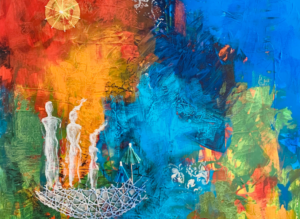The Sounds of Passover Across Jewish Cultures
Explore classic Passover songs from diverse Jewish voices
Published Mar 16, 2023

For almost as long as Jews have been around, we have been observing and celebrating Passover, the holiday of liberation, springtime, and returning home from a land not our own. It is fitting, then, that the Jewish people have songs not just in Hebrew but in their diverse regional tongues, commemorating what it means to be free.
Languages like Yiddish, Ladino, Bukharian, and Jewish English all have their own versions of iconic songs like “Dayenu”, “Who Knows One”, and “Chad Gadya”, all with unique vocabulary, melodies, and sounds adopted from surrounding societies.
Notice how the Four Questions in Yiddish borrows sounds from High German as well as ancient Hebrew, how “Chad Gadya” in Ladino sounds completely different from the same song in Bukharian, yet can be played with the same instruments, and how “Dayenu” in Jewish Neo-Aramaic is so similar to its Hebrew cousin.
Passover songs were incorporated into the Haggadah centuries ago, and they persist today in their various iterations across regional and traditional boundaries. These songs provide a metaphorical home for our people, from the land of Egypt thousands of years ago to next year in Jerusalem.
“Dayenu” in Jewish Neo-Aramaic
“Who Knows One” in Jewish English
“Who Knows One” in Judeo-Arabic
“Chad Gadya” in Ladino
“Chad Gadya” in Bukharian
“Di Fir Kashes” (Four Questions) in Yiddish
We selected this content as a representation of Jewish unity and diversity. In so many Jewish traditions, from Ashkenazi to Sephardic to American to Bukharian, these songs and their Passover context are a staple of the Jewish experience.
Many Jews who profess little religious or traditional affiliation often recall Passover seders more vividly than Shabbat services. Song, too, is an ancient and modern way to preserve history, share stories, build a shared identity, and pass traditions to the next generation. To incorporate one of the most core Jewish practices with the universality of song, across continents and tongues, is a crucial way to join hands (and voices) in Jewish pride.
As Jews of varied backgrounds join together in the experience of each other’s regional customs, especially that most intimate custom of song, Judaism becomes more unified, though, crucially, not uniform.
We embrace the differences between Ladino and Bukharian, Yiddish and Jewish English, as we simultaneously share in the joy of a deep and full Judaism. Had we only had one way to profess our joy in peoplehood and liberation, dayenu. But we have so many, and it is only right that we take pride in that.
The HUC-JIR Jewish Language Project promotes research on, awareness about, and engagement surrounding the many languages spoken and written by Jews throughout history and around the world, from Ladino and Yiddish to Judeo-Arabic and Judeo-Malayalam.
Reflections
For lovers of song:
Songs like "Chad Gadya" and "Who Knows One" are cyclical and repetitive in nature. How might this represent or symbolize Passover tradition and Judaism broadly?
For parents:
How do songs like these help you imbue Jewish values into your children? What do you try to teach them through song?
For language connoisseurs:
Compare two (or more!) versions of "Who Knows One" on this page. What words do they have in common? How do the songs differ, not only in language but in content?
Want more?
Get curated JewishArts.org content in your inbox


